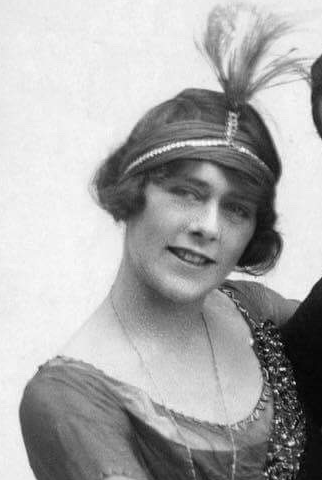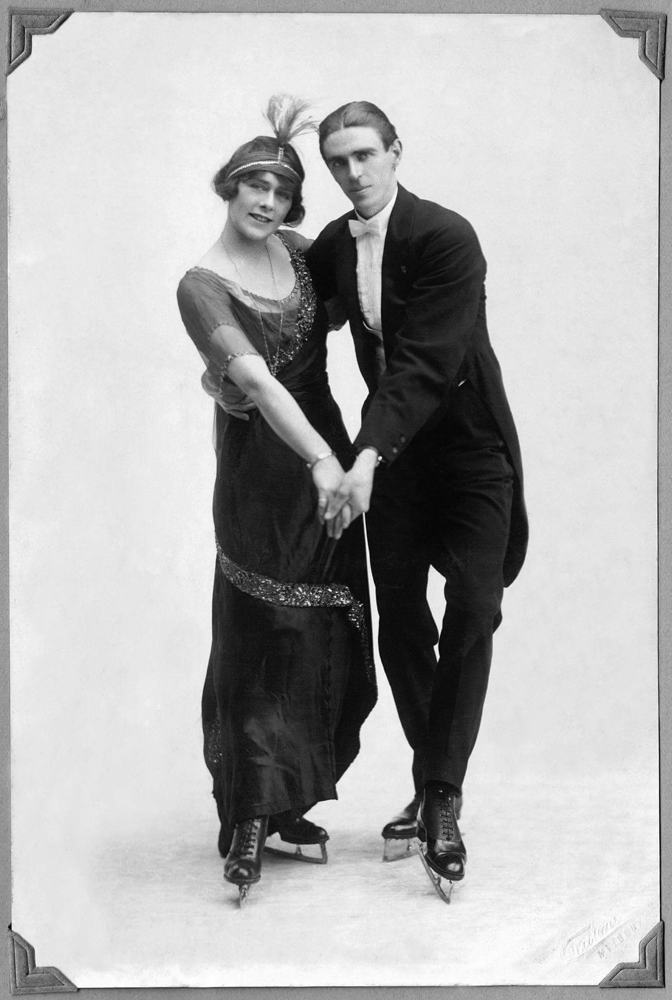

With Cyril MacGillicuddy, September 1913, courtesy Simon Yencken. The pair danced a rag-time two-step at a carnival in August 1913, a few months before Billy announced her engagement. They won the Waltzing Championship in September and Billy also won the Ladies' Championship. Photo by Talma & Co Melbourne, published in Punch. [5]
CAREER SUMMARY
Birth
1892
St Kilda Melbourne Australia
Death
1962
Melbourne Australia
Club
Melbourne Glaciarium Skating Club, Princes Skating Club London
Australian Ladies Championships
1913 [Ladies' Champion]
1913 [Waltzing Champion with Cyril MacGillicuddy]
Regular skater at Prince's, London
BORN PHYLLIS HAMMOND CLEGG in St Kilda in 1892, she was the daughter of Nottingham-born Colonel William Hammond Clegg (1857–1932) and Mary Ann Ellen Goodall. A first cousin of John Goodall of Ice Hockey Cup fame through her mother Mary, the daughter of Goodall's grandfather. Her father became managing director of John Goodall & Co, the Queen Street stock and share brokers where her cousin worked.
Billy and her two sisters grew up at Mendip, 36 Grey Street, St Kilda, to become leading members of Melbourne society. Hundreds of young people attended the fancy dress dances Billy and her sister Dolly hosted in the St Kilda Town Hall and elsewhere during the early-1900s. At school she was expert at swimming, golf, hockey and rowing. Both girls were regulars at the first balls at Melbourne Glaciarium, where Billy ranked among the top Australian skaters of her time, on a par with Mirey Reid, Doris Armitage, Merna MacGillicuddy, and Sydney's Fannie Salmon (née Trotter). In 1914, Trotter was the first Australian woman to compete in the ISU World Figure Skating Championships, but representing Sweden.
Billy and Claude Langley, the prime mover of the national skating association in Melbourne in 1910-11, were the principal pair of five couples who helped at the opening night ceremony of Sydney Glaciarium in 1907. [4] She was also very popular at Prince's Skating Club in London, one of the design influences of the first rinks in Adelaide and Melbourne. Her "waltzing was a joy for both partner and spectator in the years just before the First World War at Prince's," wrote British skater Joan Dean in the History of Ice Skating, [416] "where she attracted great attention and with whom we all wanted to dance". She no doubt trained with James Brewer and Miss Dent, the Melbourne Glaciarium instructors from Prince's, the home ice of Australia's first skating instructors. She caused a similar skating sensation at the Adelboden Grand Hotel in Switzerland in 1912, and won first prize at the Ball as the "Merry Widow".
In 1913, at the age of 21, she became the third Australian Ladies' Skating Champion before the titles were contested independently of the association in Sydney. [5, 377] She also won the national Waltzing title with Cyril Macgillicuddy. [5] A noted sportswoman, she was a member of the Sorrento Golf Club and drove John Goodall's Aston Martin in the RACV Hill Climb at Belgrave in Victoria in 1924. She danced on ice at Melbourne Glaciarium that year with Hilda Grice and others in a butterfly ballet choreographed by future World's Professional Pairs champions, Albert Enders and Sadie Cambridge. [7] She also became a skilled skier at Mt Kosciusko, always motivated by the challenge of learning the skills of a sport, rather than winning competitions.
On February 17th 1914, she married Simon Fraser, an Olympic rower, a VFL footballer with Essendon and University, and goalie for the Beavers ice hockey club in Melbourne, one of Australia's original four. She spent 5 years — most of her married life — at Nyang, the Fraser family station of 35,000 sheep managed by Simon near Moulamein, NSW. She helped with the station work, especially during the drought in 1914 and the flood in 1917. In 1919, both fell ill from pneumonic influenza at Penshurst in Victoria after attending the Warrnambool races. Her husband died from the illness aged 33. His legacies are the Simon Fraser Boathouse near Princes Bridge in Melbourne, his family's memorial gift to Melbourne Grammar, and the Simon Fraser Scholarship at the University of Melbourne.
In 1928, the year after the aero club movement allowed women to gain a pilot's license, Billy was a pupil of Captain F G M Sparks at the Stag Lane Aerodrome in England, and became one of the first women aviators in Victoria. [2] By the end of 1929, the number of women pilots had increased to 18. [1] She was one of the six "lady pilots" who welcomed Amy Johnson to Melbourne on her record-making solo flight from England in 1930. [7]
Billy often stayed with her mother-in-law, Lady Fraser, at Nyland in Sorrento, built by her grandfather John Goodall, and attended many of the same social events, including meetings at Government House, Flemington and Caulfied Cup meetings. Former Prime Minister Malcolm Fraser was a nephew by marriage. Like Lady Fraser, she frequently contributed to charity fundraising and the war effort, and continued to be known as Mrs Simon Fraser until her death in Melbourne in 1962.
Tony Yencken recalls "...when she was aged 60, she said to me one day at Portsea, 'Tony — I have never tried water ski-ing, would you show me how to do it?' My heart sank as I said that I would be pleased to do so, for I expected the endless attempts involved in getting a novice up on top of the water, and then the endless attempts for them to get stabilized, especially with someone of her age. However, a couple of days later we were in the boat together with the skis. She hopped into the water, put on the skis, put the tips up as instructed, I straightened the tow rope and started to apply the engine power.
"I was amazed, she rose out of the water like a professional and we set off for a run alongside Shelly Beach. After a while she signaled that she wished to return, and on approaching the baths she cast off the rope and sailed across the water until she sank. 'Thank you' she said, 'I enjoyed that, I always wanted to know what it would be like. I don't want to do it again, I'm satisfied.'" [2]
Billy is interred at Brighton Cemetery in Melbourne with her mother and father.
| First NISAA Ladies Skating Champions | ||
| Year | Name | State |
| 1911 | Miss M Reid (Mireylees) | Victoria |
| 1912 | D Wilson | Victoria [2, 3] |
| 1913 | P Hammond-Clegg (Billy) | Victoria |
| 1914 | F Hartkopf (Frieda) | Victoria |
| 1915 | M MacGillicuddy (Merna) [1] | Victoria |
| 1916 | E Roche | Victoria |
| 1917 | A Abrahams (Alice) | Victoria |
| 1918 | D Armytage (Doris) | Victoria |
| 1919 | D Armytage | Victoria |
| Source: Handbook of the National Ice Skating Association of Australia, c 1920. [377] | ||
1. Merna MacGiilicuddy was the only sister of Cyril MacGillicuddy.
2. In 1912, Miss Tamkin (NSW) was second to Wilson. (The Argus, Melbourne, 10 Aug 1912, p 17)
3. Wilson was from London. (Punch, Melbourne, 12 Sep 1912, p 43)
1 • 377 The Handbook of the National Ice Skating Association of Australia, c. 1920, shows national skating titles were contested by skaters from both Victoria and New South Wales during the second year of the National Ice Skating Association founded in Victoria in 1911. Chas Maclurcan (NSW) won the 1912 Australian Men's Championship , and Miss Tamkin (NSW) runner-up of the 1912 Ladies' Championship. The following quote by an association member was published in Punch in Melbourne in 1912:
"It was very satisfactory to have competitors from Sydney, and it is hoped more will come over next season. Special efforts are being made here and in Sydney to amalgamate with the Figure Skating Club of New South Wales and to have one controlling body ("The Association"), each State being a branch. It is hoped to bring this about at the end of next season. The association events would then be held alternatively in each State... this is the aim of the association, to see an Australian skater carry off the World's Championship. Something then will have been achieved." [4]Sometime later, New South Wales decided to conduct their own national championships until finally merging with Victoria in 1931. Isidor Beaver, president of the NISAA in these years, is pictured with the Beavers IHC in the image gallery below. The prizes for the national titles were large, framed certificates, illuminated, and carved by the donor with spaces for photographs of the winners. The medals were the Southern Cross in diamonds, attached to broad bands on pins. The property of the association, the medals were challenged each season and passed on from champion to champion. [4]
2 From a family of notable Victorian sportsmen and theatricals, Cyril Macgillicuddy was a Goodall Cup champion goaltender in 1910; a figure skating gold medalist; a State and National pairs and dance champion several times; and Australia's first International Skating Union (ISU) judge. He later played one of the significant roles in providing continuity for ice sports in Victoria, as a founder and chairman of directors of Glaciarium Ltd, the purchaser of Melbourne Glaciarium in the Twenties, and operator until it closed in the Fifties. He was a founding member of the first national ice skating association in 1931, "which paved the way for the fine successes of Australian skaters of today", wrote Joan Dean. "Ably led by Charles MacLurcan and Dr Cyril MacGillicuddy, who started National tests on the lines of those of the NSA, Australians now rank as worthy contenders in International Competitions".
416 The History of Ice Skating, 1956. Out of print. Fred and Joan Dean, editors of Ice and Roller Skating Magazine, England.
3 Billy's sister (Mary) Hope married Edward Druce Yencken and had 3 children. Her older sister, Dolly, married Captain Harold Hall, whose father had been part owner of the Mount Morgan goldmine, and the couple lived in England where she became a keen gardner. It was Harold Hall who sent John Goodall his Aston Martin racer. In August 1949, The Argus proudly reported Dolly had been awarded seven firsts, three seconds and one third at the Royal Horticultural Flower Show in Chelsea with gladioli from Australia. The portrait Dolly, daughter of Hammond Clegg Esq. painted in July 1896 by E Phillips Fox, is in the National Gallery of Victoria. Dolly would have been about 6 years-old when the portrait was painted. [7]
4 Australian Star, Sydney, 26 Jul 1907, p. 8. The pair exhibition was Billy Clegg and Claude Langley. The Victorian pairs in the opening waltz were: Molly Atherton and Jim Thonemann, Winnie Williams and Ramsay Salmon, Miss Peacock and Gordon Langridge, O Atherton and Claude Langley, Billy Clegg and G Smith.
5 Punch, Melbourne, 18 Sep 1913.
203 The Argus, Melbourne, 26 Sep 1924, p 12. Skating Carnival.
Ross Carpenter, 'Clegg, Billy (1892 - 1962)', Legends of Australian Ice, Melbourne, Australia, http://icelegendsaustralia.com/legends-2/bio-clegg.html, accessed online .
[2] Tony Yencken email October 12th 2017
[3] Skaters of Sydney: Sydney Glaciarium, Ross Carpenter, 2017. Online
[4] Annual Championships at the Glaciarium, Punch, Melbourne, Sep 12th 1912.
[5] Fraser, Simon (1886-1919), Obituaries Australia. Online
[6] A Usual, Unusual Woman's Life in the 19th Century: Amalie Christine Jencken, 2016, Victoria Joan Moessner, Page Publishing Inc NY, 1st Ed.
[7] E. Phillips Fox, Dolly daughter of Hammond Clegg Esq., NGV Art Journal 53, Elana Taylor, Curator, Australian Art, National Gallery of Victoria (2014).
[8] Clegg, William Hammond (1857-1932), Obituaries Australia. Online



